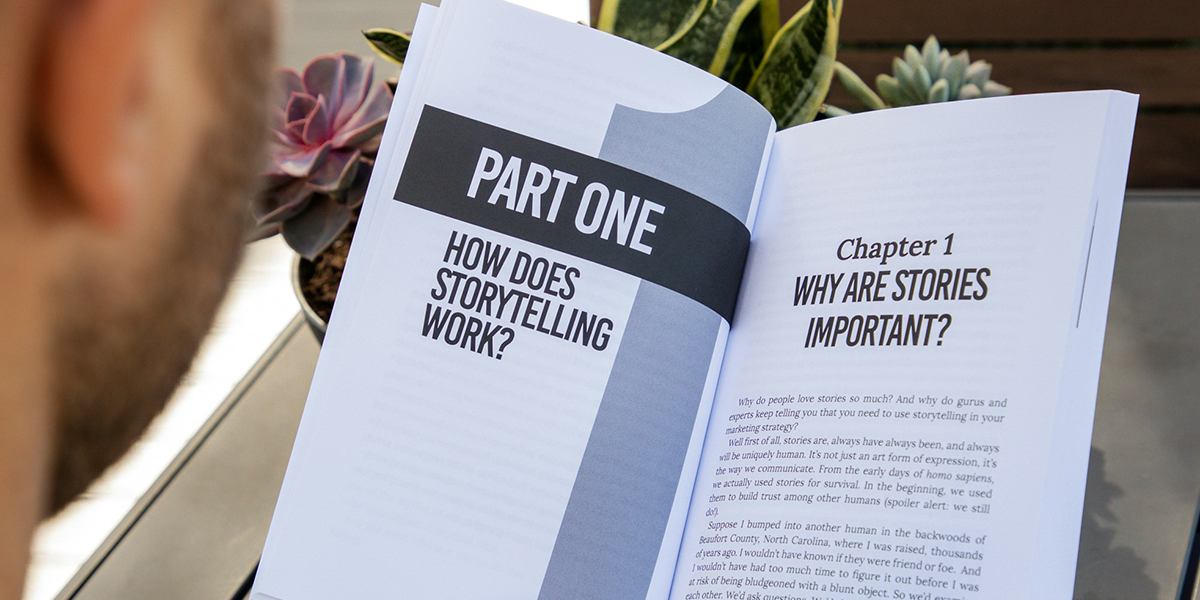Using storytelling to help your nonprofit’s marketing
The first thing that comes to mind when you hear the word storytelling may be your favorite books, plays and movies, but storytelling isn’t just for fiction, it’s for your nonprofit’s marketing too! In fact, 75% of customers today want the companies they interact with to use storytelling in their marketing.
Let’s dive into the ins and outs of storytelling and how your nonprofit can use this tool in your marketing campaigns!
The importance of storytelling
One of the most important parts of marketing, especially for nonprofits, is forming connections with the people you want to reach. And storytelling is an excellent tool to help you do just that. Implementing storytelling into your general marketing and ad marketing campaigns makes it easier for your constituents to resonate and relate to your organization. This connection is crucial in a world so saturated with digital content. You want your marketing materials to not only stand out but be an authentic, personable representation of your nonprofit. The more your organization relates to its audience, the easier it will be to meet goals like gaining more supporters, recruiting volunteers and spreading general awareness about the important work you do.
Storytelling basics
Every successful story, whether it’s a movie on the big screen or a social media post, contains a variation of these basic components.
- Characters: When you think of your favorite story, chances are the characters are what comes to mind first. They are who the story revolves around, and the audience relates and connects to them. The characters for your nonprofit can be the people you serve, the sponsors that support you or even your staff.
- Setting: This is where the story takes place. Depending on the story you’re telling for your organization, your setting can be your office, an event you are hosting or your general community.
- Conflict: Conflict elicits emotions and makes the audience connect through relatable experiences. It is essential to storytelling. Your conflict won’t be the same as your favorite movie, but it can include challenges your nonprofit helps to tackle in its community.
- Structure: Plot is the structure. There should be a beginning, a middle and an end. Your structure will change based on the type of story you are telling.
- Resolution: A resolution should wrap up the story and leave audiences feeling ready to act the way you need them to act. This is a call-to-action, and it will change based on your goals for the story you are telling. Calls-to-action can include things like signing up for services, encouraging donations and volunteering.
No matter the story you are telling, you will want to make sure you are:
- Promoting what makes you unique.
- Motivating your audience to act in the way you want them to act.
- Engaging your audience so they feel connected to you and your story.
- Offering valuable information and insight.
- Sharing relatable content.
Using storytelling for your nonprofit
You now know the general basics behind storytelling, so let’s break down what you need to do to successfully harness this tool for your organization. To start telling stories for your nonprofit, you’ll need to:
- Know your audience: Think of your audience as your roadmap. By understanding the concepts that attract and resonate with them, you can dictate your storytelling decisions to ensure you are hitting those key points. For example, if your audience is middle-aged professionals, chances are you won’t be creating dance Tik-Toks to resonate with them. A great way to get to know your audience and outline where and how they communicate is creating written personas for them. You can learn more about the importance of persona’s with this
- Decide your story’s purpose: Set a goal for what you are trying to accomplish by telling your story and decide what your call-to-action will be. Goals can include getting people to donate or buy tickets for an event you are hosting, spreading awareness about your organization or showcasing a successful project your organization completed.
- Choose a story medium: Knowing the format of your story will help you outline the different components you will need to create it. For example, if you are writing a blog, you will need longform copy written. If you are speaking in a presentation, you will need to create a PowerPoint with visuals and concise information. Whatever medium you choose will dictate the items you need to create it – copy, graphics, video footage, etc.
- Plan and structure your story: Create a detailed outline through things like storyboards, wireframes or PowerPoint presentations. This structure will help you keep the original vision and goals intact as you go through the creation process.
Where to start telling your stories
Once you have an idea of the stories you want to tell and the goals behind them, it is time to start sharing them with your audiences. And if you want more insight into some of the platforms below and what they are best used for, check out this blog!
You can tell your nonprofit’s stories on:
- Your website: Include content on your homepage, about page, staff page and your blog (if you have one). On these pages, you can implement short video content and photos to help make your site more dynamic and less text heavy. Visuals are always great for helping to tell a story.
- Facebook, Instagram, X (formerly known as Twitter) and TikTok: Content on these platforms should be kept short, sweet and attention-catching for optimal performance. Facebook and Instagram content can be made up of photos with captions, <60 second videos and 15-30 second Reels. For X, content can include photos with brief captions and videos around 20 seconds. You can post photos of your organization at work, short highlight videos of an event you held, infographics that display key data about your nonprofit like numbers served and facts about what it is your organization does. For TikTok, focus on very short videos, around 10-20 seconds long that lead with a hook and include some kind of CTA to get your viewers involved.
- YouTube: This platform is great for longer video content where you have more information to share. These can be videos where you interview the people you serve or showcase more in-depth data and facts about your organization and the work that you do. YouTube can also be a good place to post shorter content with Shorts. These quick videos are 60 seconds or under so content should be catchy, dynamic and well branded so viewers recognize you.
- Email newsletters: Emailing your constituents helps keep them up to date with the goings on of your organization so they feel involved and included. But make sure the content you share is relevant and interesting and be careful not to have newsletters that are bogged down by lots of copy.
- Traditional media: This includes things like annual reports, update letters, event invitations, etc. It is important to use graphics and high-quality photos to demonstrate your story through traditional media, as this keeps things eye-catching and easy to read.
Using storytelling in your marketing, no matter what platform you choose to use, will help your nonprofit develop deeper connections with your constituents and help you accomplish your organizations goals!
Not sure exactly what to do or need help? Contact us to learn how we can help you send better emails.

Dot Org Content Team
Dot Org Solutions works with nonprofits of all types to raise more money, communicate effectively and educate their constituents so they can build better communities. Our proven systems and years of experience help reduce the anxiety and stress felt by nonprofit teams, giving them more time to focus on other important things.

